

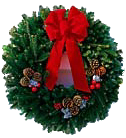
Christmas Store
The holidays are just around the corner so now is the time to fetch the finest gifts for the Labrador Lover on your Christmas list. We have over 100 gifts $50.00 and under. Visit our Christmas Store.
For the Lab
Bedding
Coats
Collars and Leads
Dog Bowls
Feeding Stations
Spa and Grooming
Toys and Treats
Travel and Accessories
For the Lab Lover
Apparel
Cards and Giftwrap
Fine Accessories
Gifts and All Occasions
Jewelry
Kids Only
For the Lab Home
Artwork
Books
Garden and Outdoor
Home Furnishings
Kitchen Accessories
Pillows, Throws, and Rugs
Gift ServicesGift Boxes
Gift Certificates
Running Rings around the Seals with Dr. Cooper
By Josh Hagy
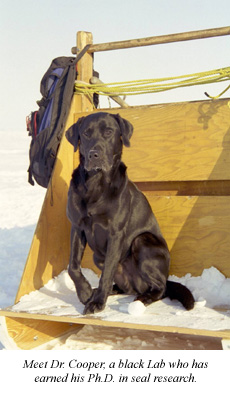 On any given day in Alaska, you’ll find Dr. Cooper out on the snow and ice, searching for ringed seal breathing holes and lairs that are buried snugly beneath the snow that blankets the sea ice. It’s not exactly your average day at work, but then again, Dr. Cooper isn’t quite what you would expect either. He’s a six-year-old black Lab.
On any given day in Alaska, you’ll find Dr. Cooper out on the snow and ice, searching for ringed seal breathing holes and lairs that are buried snugly beneath the snow that blankets the sea ice. It’s not exactly your average day at work, but then again, Dr. Cooper isn’t quite what you would expect either. He’s a six-year-old black Lab.
“He’s got his Ph.D. in seals,” joked Dr. Brendan Kelly, Vice Provost for Research and Dean of Arts and Sciences at the University of Alaska Southeast. Brendan works with Cooper, and sometimes other Labs, to find seals hidden beneath the Alaskan ice.
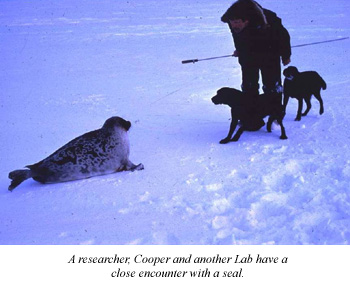 “The idea comes from Inuit hunters,” said Brendan, who has been working with seals since the 1980s. He learned to use dogs to find seals when working with colleagues in Canada. “I have to admit, when I first heard about it, I was a bit skeptical.”
“The idea comes from Inuit hunters,” said Brendan, who has been working with seals since the 1980s. He learned to use dogs to find seals when working with colleagues in Canada. “I have to admit, when I first heard about it, I was a bit skeptical.”
Regardless of his skepticism, Brendan made a trip to Canada, along with a Lab and an English Springer, to meet with a colleague and an Inuit to begin training the dogs to find seals. What he found while attempting to train the pair surprised him.
“What can I say?” he asked with a laugh. “The Lab was easy to train and the Springer was anything but easy to train. Labs are just so darn tractable. You could certainly train other dogs, but Labs definitely take to the training.”
Training at first involves burying sealskin flippers in the snow and teaching a Lab such as Cooper to hunt for the scent. Once the dog finds them, Brendan and his colleagues begin praising them and giving the command “natchiq”, which is the Inupiaq word for ringed seal. Now, Brendan will take out a younger dog along with Cooper to teach the younger, less experienced dog the tricks of the seal sniffing trade.
“What typically happens is that we take a new dog out with the older, more experienced dog for a month or two,” explained Brendan. “The experienced dog will lead us to a hole and as soon as the trainee picks up the scent, we start giving them the command we want them to associate with the hole and start giving them a lot of praise. There really is a lot of positive reinforcement involved.” The training is a slow process that can take months, even with a Lab that is a natural retriever. But the effort is worth the result, since not even infrared, heat detecting cameras are as sensitive or as accurate as Cooper’s nose.
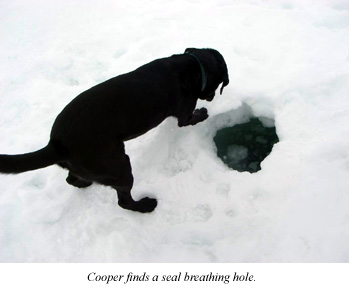 “We’re happy if a dog has started to solo by the end of its first spring on the ice,” said Brendan. “Often, that does not happen until the second season. Of course, we always start with dogs that are well trained in the basic commands.” With the natural energy and retrieving skills of a Lab, Brendan found a perfect research partner in Cooper.
“We’re happy if a dog has started to solo by the end of its first spring on the ice,” said Brendan. “Often, that does not happen until the second season. Of course, we always start with dogs that are well trained in the basic commands.” With the natural energy and retrieving skills of a Lab, Brendan found a perfect research partner in Cooper.
“Cooper actually belongs to a friend of mine in Anchorage,” he explained. “She’s had him since he was a pup. She has done work in the Arctic on some political issues. She knew about my work and was interested. I don’t remember exactly how I talked her into it, but she is very into Labs and was hoping that he could go to college and get his degree. He’s definitely earned it.”
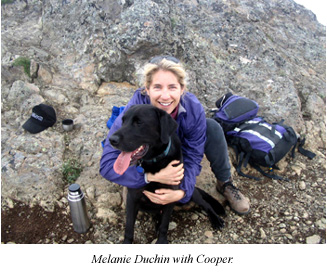 While Brendan may not remember the details of how he was able to get Cooper out on the ice, his owner, Melanie Duchin, can relate the tale. “At some point when Cooper was still a young puppy, I think it was late 2000 or early 2001, Brendan came to Anchorage on business and we met for a few drinks,” she said. “One whiskey led to another, and when I was a little bit tipsy he asked me what I thought about Cooper being trained to be a seal dog. Now, I'm not saying that it was the whiskey that influenced my decision, but I immediately said yes and was thrilled at the prospect of my dog getting a chance to work with Brendan on the ice. So, in the spring of 2001, Cooper headed north to Prudhoe Bay with Brendan.”
While Brendan may not remember the details of how he was able to get Cooper out on the ice, his owner, Melanie Duchin, can relate the tale. “At some point when Cooper was still a young puppy, I think it was late 2000 or early 2001, Brendan came to Anchorage on business and we met for a few drinks,” she said. “One whiskey led to another, and when I was a little bit tipsy he asked me what I thought about Cooper being trained to be a seal dog. Now, I'm not saying that it was the whiskey that influenced my decision, but I immediately said yes and was thrilled at the prospect of my dog getting a chance to work with Brendan on the ice. So, in the spring of 2001, Cooper headed north to Prudhoe Bay with Brendan.”
While Melanie has never seen Cooper in action on the Arctic ice, she has seen him play enough to know that he would make a wonderful seal dog. “As Brendan tells it, Cooper took to his job as a seal dog immediately and needed little training and instruction to get the hang of tracking ringed seals on the ice,” she said. “I have never seen Cooper on the ice, but I can vouch for his obsessive-compulsive behavior when it comes to fetching sticks, frisbees, tennis balls or toys.”
While Cooper and Melanie make a great pair, it was chance that they ended up together. “I first met Cooper when he was just a few days old and could fit in the palm of my hand. I had been looking for a Labrador Retriever puppy and a friend of mine who knows good Labrador Retriever blood lines told me about Cooper's litter,” related Melanie. “It was a litter of four males and five females, I really wanted a male, but all of the males had been spoken for, so I was on the list for getting a female.”
As it turned out, Melanie would have the opportunity to take home a male after all. “A few weeks later, the owners told me that the person who was to get Cooper saw that he had small patches of white above each paw pad, and because of this, he didn't want him any more. Guess the guy wanted a completely black Lab. So that is how I wound up with Cooper (whose full name is Special Agent Dale Cooper, after the FBI agent in the TV show "Twin Peaks"). I took him home with me on December 13, 2000. He's been my constant companion ever since.”
Melanie’s constant companion has definitely proved to be worth his weight on the dog sled by finding thousands of seal holes. “We don’t catch a seal at every hole, but we are probably pushing having tagged 200 seals.” Once they find the seals, they use a ‘live capture’ net to keep the seals from escaping and then take hair and skin samples and tag them. The tags allow researchers to track the seals for more than a year.
Brendan’s research is aimed at discovering information about ringed seal movements and populations to predict the impact of decreasing sea ice and early snowmelt in the Arctic. Brendan and Cooper work mainly through April, May, and June, and while those may sound like warm and sunny summer months, temperatures are quite a bit lower in Alaska. Fortunately, Cooper and the other Labs he occasionally works with are accustomed to the cold weather.
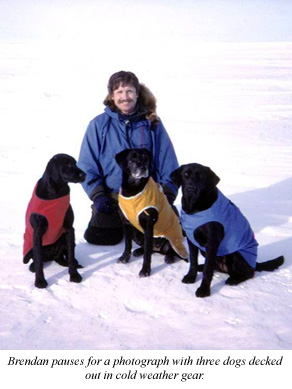 “They are amazingly cold tolerant,” said Brendan. “I have had dogs working in minus 70 degree wind chills.” Even though Cooper is one tough Lab, Brendan still has to take special precautions to combat such cold conditions.
“They are amazingly cold tolerant,” said Brendan. “I have had dogs working in minus 70 degree wind chills.” Even though Cooper is one tough Lab, Brendan still has to take special precautions to combat such cold conditions.
“As long as they are moving, they are fine,” he explained. “But when they stop moving around, you have to take care to see that they do not get too cold. When they hold still for any reason, we usually put a specially made coat on them.” Brendan also has to watch out for ice conditions to avoid abrasions on Cooper’s paws. “If the ice gets rough then there are booties they wear that protect their feet. If the ice gets really rough, then Cooper can ride in the sled. Most dogs do not care to wear the booties ; it’s just not their preference. But they will if they have to. I also have to watch for frostbite on exposed skin.”
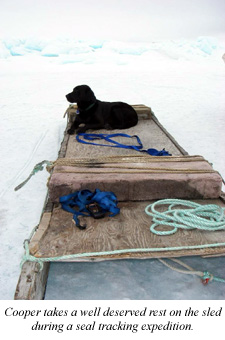 Brendan now only uses Labs in his research excursions. Cooper has proved to be an excellent partner, and Brendan has found success with other Labs as well. “I’ve never had a problem with Labs. They’re a wonderful breed of dog.”
Brendan now only uses Labs in his research excursions. Cooper has proved to be an excellent partner, and Brendan has found success with other Labs as well. “I’ve never had a problem with Labs. They’re a wonderful breed of dog.”
Labs are a wonderful breed indeed, but for Melanie, there’s no other dog but Cooper. “Cooper is also a really big goofball. He will walk around with three or four toys in his mouth, fetch a tennis ball over and over until he collapses in a heap, loves to drop spit-covered toys into folks' laps, lie on his back with his paws in the air so folks will scratch his belly, and he can clear a room with his flatulence,” she said.
With all that natural exuberance, Cooper’s motivations can’t help but remain a mystery. “Brendan and I wonder if he is such a good seal dog because he knows its work or because it is all one big game to him. I'm pretty sure it's the latter,” she said.
Whether he’s working or playing, Cooper is without a doubt one happy Lab.
Click here to go back to Lab of the Month
By Josh Hagy
 On any given day in Alaska, you’ll find Dr. Cooper out on the snow and ice, searching for ringed seal breathing holes and lairs that are buried snugly beneath the snow that blankets the sea ice. It’s not exactly your average day at work, but then again, Dr. Cooper isn’t quite what you would expect either. He’s a six-year-old black Lab.
On any given day in Alaska, you’ll find Dr. Cooper out on the snow and ice, searching for ringed seal breathing holes and lairs that are buried snugly beneath the snow that blankets the sea ice. It’s not exactly your average day at work, but then again, Dr. Cooper isn’t quite what you would expect either. He’s a six-year-old black Lab.“He’s got his Ph.D. in seals,” joked Dr. Brendan Kelly, Vice Provost for Research and Dean of Arts and Sciences at the University of Alaska Southeast. Brendan works with Cooper, and sometimes other Labs, to find seals hidden beneath the Alaskan ice.
 “The idea comes from Inuit hunters,” said Brendan, who has been working with seals since the 1980s. He learned to use dogs to find seals when working with colleagues in Canada. “I have to admit, when I first heard about it, I was a bit skeptical.”
“The idea comes from Inuit hunters,” said Brendan, who has been working with seals since the 1980s. He learned to use dogs to find seals when working with colleagues in Canada. “I have to admit, when I first heard about it, I was a bit skeptical.”Regardless of his skepticism, Brendan made a trip to Canada, along with a Lab and an English Springer, to meet with a colleague and an Inuit to begin training the dogs to find seals. What he found while attempting to train the pair surprised him.
“What can I say?” he asked with a laugh. “The Lab was easy to train and the Springer was anything but easy to train. Labs are just so darn tractable. You could certainly train other dogs, but Labs definitely take to the training.”
Training at first involves burying sealskin flippers in the snow and teaching a Lab such as Cooper to hunt for the scent. Once the dog finds them, Brendan and his colleagues begin praising them and giving the command “natchiq”, which is the Inupiaq word for ringed seal. Now, Brendan will take out a younger dog along with Cooper to teach the younger, less experienced dog the tricks of the seal sniffing trade.
“What typically happens is that we take a new dog out with the older, more experienced dog for a month or two,” explained Brendan. “The experienced dog will lead us to a hole and as soon as the trainee picks up the scent, we start giving them the command we want them to associate with the hole and start giving them a lot of praise. There really is a lot of positive reinforcement involved.” The training is a slow process that can take months, even with a Lab that is a natural retriever. But the effort is worth the result, since not even infrared, heat detecting cameras are as sensitive or as accurate as Cooper’s nose.
 “We’re happy if a dog has started to solo by the end of its first spring on the ice,” said Brendan. “Often, that does not happen until the second season. Of course, we always start with dogs that are well trained in the basic commands.” With the natural energy and retrieving skills of a Lab, Brendan found a perfect research partner in Cooper.
“We’re happy if a dog has started to solo by the end of its first spring on the ice,” said Brendan. “Often, that does not happen until the second season. Of course, we always start with dogs that are well trained in the basic commands.” With the natural energy and retrieving skills of a Lab, Brendan found a perfect research partner in Cooper.“Cooper actually belongs to a friend of mine in Anchorage,” he explained. “She’s had him since he was a pup. She has done work in the Arctic on some political issues. She knew about my work and was interested. I don’t remember exactly how I talked her into it, but she is very into Labs and was hoping that he could go to college and get his degree. He’s definitely earned it.”
 While Brendan may not remember the details of how he was able to get Cooper out on the ice, his owner, Melanie Duchin, can relate the tale. “At some point when Cooper was still a young puppy, I think it was late 2000 or early 2001, Brendan came to Anchorage on business and we met for a few drinks,” she said. “One whiskey led to another, and when I was a little bit tipsy he asked me what I thought about Cooper being trained to be a seal dog. Now, I'm not saying that it was the whiskey that influenced my decision, but I immediately said yes and was thrilled at the prospect of my dog getting a chance to work with Brendan on the ice. So, in the spring of 2001, Cooper headed north to Prudhoe Bay with Brendan.”
While Brendan may not remember the details of how he was able to get Cooper out on the ice, his owner, Melanie Duchin, can relate the tale. “At some point when Cooper was still a young puppy, I think it was late 2000 or early 2001, Brendan came to Anchorage on business and we met for a few drinks,” she said. “One whiskey led to another, and when I was a little bit tipsy he asked me what I thought about Cooper being trained to be a seal dog. Now, I'm not saying that it was the whiskey that influenced my decision, but I immediately said yes and was thrilled at the prospect of my dog getting a chance to work with Brendan on the ice. So, in the spring of 2001, Cooper headed north to Prudhoe Bay with Brendan.”While Melanie has never seen Cooper in action on the Arctic ice, she has seen him play enough to know that he would make a wonderful seal dog. “As Brendan tells it, Cooper took to his job as a seal dog immediately and needed little training and instruction to get the hang of tracking ringed seals on the ice,” she said. “I have never seen Cooper on the ice, but I can vouch for his obsessive-compulsive behavior when it comes to fetching sticks, frisbees, tennis balls or toys.”
While Cooper and Melanie make a great pair, it was chance that they ended up together. “I first met Cooper when he was just a few days old and could fit in the palm of my hand. I had been looking for a Labrador Retriever puppy and a friend of mine who knows good Labrador Retriever blood lines told me about Cooper's litter,” related Melanie. “It was a litter of four males and five females, I really wanted a male, but all of the males had been spoken for, so I was on the list for getting a female.”
As it turned out, Melanie would have the opportunity to take home a male after all. “A few weeks later, the owners told me that the person who was to get Cooper saw that he had small patches of white above each paw pad, and because of this, he didn't want him any more. Guess the guy wanted a completely black Lab. So that is how I wound up with Cooper (whose full name is Special Agent Dale Cooper, after the FBI agent in the TV show "Twin Peaks"). I took him home with me on December 13, 2000. He's been my constant companion ever since.”
Melanie’s constant companion has definitely proved to be worth his weight on the dog sled by finding thousands of seal holes. “We don’t catch a seal at every hole, but we are probably pushing having tagged 200 seals.” Once they find the seals, they use a ‘live capture’ net to keep the seals from escaping and then take hair and skin samples and tag them. The tags allow researchers to track the seals for more than a year.
Brendan’s research is aimed at discovering information about ringed seal movements and populations to predict the impact of decreasing sea ice and early snowmelt in the Arctic. Brendan and Cooper work mainly through April, May, and June, and while those may sound like warm and sunny summer months, temperatures are quite a bit lower in Alaska. Fortunately, Cooper and the other Labs he occasionally works with are accustomed to the cold weather.
 “They are amazingly cold tolerant,” said Brendan. “I have had dogs working in minus 70 degree wind chills.” Even though Cooper is one tough Lab, Brendan still has to take special precautions to combat such cold conditions.
“They are amazingly cold tolerant,” said Brendan. “I have had dogs working in minus 70 degree wind chills.” Even though Cooper is one tough Lab, Brendan still has to take special precautions to combat such cold conditions.“As long as they are moving, they are fine,” he explained. “But when they stop moving around, you have to take care to see that they do not get too cold. When they hold still for any reason, we usually put a specially made coat on them.” Brendan also has to watch out for ice conditions to avoid abrasions on Cooper’s paws. “If the ice gets rough then there are booties they wear that protect their feet. If the ice gets really rough, then Cooper can ride in the sled. Most dogs do not care to wear the booties ; it’s just not their preference. But they will if they have to. I also have to watch for frostbite on exposed skin.”
 Brendan now only uses Labs in his research excursions. Cooper has proved to be an excellent partner, and Brendan has found success with other Labs as well. “I’ve never had a problem with Labs. They’re a wonderful breed of dog.”
Brendan now only uses Labs in his research excursions. Cooper has proved to be an excellent partner, and Brendan has found success with other Labs as well. “I’ve never had a problem with Labs. They’re a wonderful breed of dog.”Labs are a wonderful breed indeed, but for Melanie, there’s no other dog but Cooper. “Cooper is also a really big goofball. He will walk around with three or four toys in his mouth, fetch a tennis ball over and over until he collapses in a heap, loves to drop spit-covered toys into folks' laps, lie on his back with his paws in the air so folks will scratch his belly, and he can clear a room with his flatulence,” she said.
With all that natural exuberance, Cooper’s motivations can’t help but remain a mystery. “Brendan and I wonder if he is such a good seal dog because he knows its work or because it is all one big game to him. I'm pretty sure it's the latter,” she said.
Whether he’s working or playing, Cooper is without a doubt one happy Lab.
Click here to go back to Lab of the Month
Featured Article
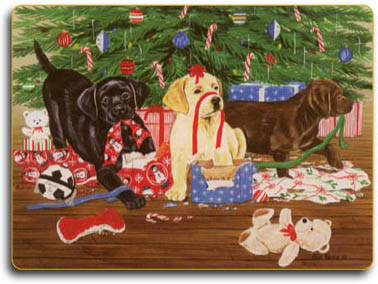 Can You Spot The Holiday Hazards?
Can You Spot The Holiday Hazards?
It’s easy for pets, especially Labradors, to get into trouble during the holidays. You may get so busy that you lose track of what is going on with your dog.
Click here to learn more about: "Can You Spot The Holiday Hazards?"
 Can You Spot The Holiday Hazards?
Can You Spot The Holiday Hazards?It’s easy for pets, especially Labradors, to get into trouble during the holidays. You may get so busy that you lose track of what is going on with your dog.
Click here to learn more about: "Can You Spot The Holiday Hazards?"
Wanted: Models

Would you like to see your Lab pictured here? Send us images of your Lab and we may include them on our Home Page!

Would you like to see your Lab pictured here? Send us images of your Lab and we may include them on our Home Page!
Labrador Library
Labrador Links
The Verstaile Lab
History of the Lab
Advice
Travel
Featured Labs
Featured Artists
Labrador Links
The Verstaile Lab
History of the Lab
Advice
Travel
Featured Labs
Featured Artists
.jpg)

